Photo by Jo Mitchell, from her Aviation Photography Page at Futurshox.net. Used by permission.
As you can see from the above photo, it goes well beyond just a simple paint job. They squared off the rudder, added some fake "Spandaus" to the cowling...and a tail gunner with his very own machine gun just behind the cockpit. Here's a close-up of the forward fuselage, courtesy of Jo Mitchell.
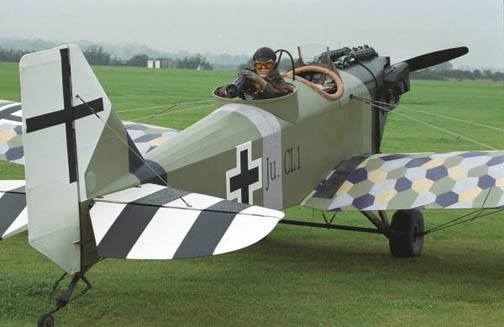
This airplane had graced the covers of Aeroplane and Kitplanes magazines in its previous guise...the airplane was a standard Fly Baby with both sets of wings. The magazines had pictures and pilot reports for both versions, monoplane and biplane. As you can see from Michael Hooker's photo, the paint job in the previous articles was very nice. I'm surprised they had the heart to cut it up and change it, but it did turn out nice.
Day had built the plane a number of years ago.
Gauld-Galliers
bought a half-share of it in the mid '90s. Since then, the
two
co-owners
converted her into a Junkers D1/CL1. Day made the
structural
changes,
and Gauld-Galliers handled the research, design, machine guns,
mock
cylinder
heads and paint job. 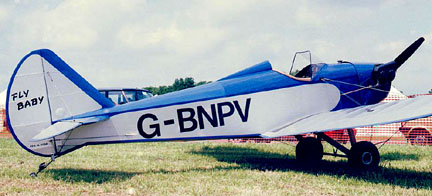
The original Junkers D1 was a very modern airplane for its day, featuring all-metal construction and some armor for the vulnerable portions of the ship. One impressive feature of the Fly Baby version is the lozenge camouflage on the wings... in 1918, the Germans used pre-printed fabric, but the two owners had to hand-paint each of those little hexagons.
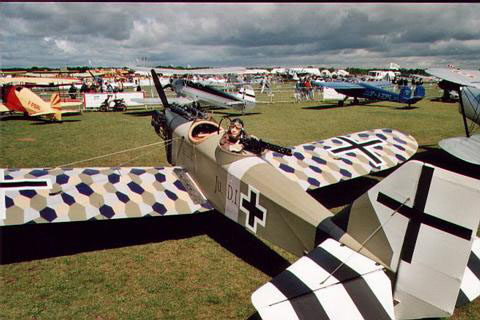 Sadly,
for
those
looking for a quick route to a two-seat Fly Baby, the gunner in
G-BNPV
isn't real. It's a dummy. However, it is a very
CLEVER
dummy.
Look at the head position of the "gunner" in the above
photo...now,
compare
it with this one, taken by Jean-Pierre Nuygen.
Sadly,
for
those
looking for a quick route to a two-seat Fly Baby, the gunner in
G-BNPV
isn't real. It's a dummy. However, it is a very
CLEVER
dummy.
Look at the head position of the "gunner" in the above
photo...now,
compare
it with this one, taken by Jean-Pierre Nuygen.
Note that the head is turned. The head swivels...it's connected to the rudder cables. Also, if you look carefully between the guns on the forward deck, you can see the fake set of "in-line" cylinder heads, just like the Mercedes engine in the original Junkers.
In case you can't tell, I *really* like what they've done. Probably the neatest aspect is the fact that the two owners really haven't changed any flight-critical structure. The main change is the change in the rudder shape, and that's primary cosmetic. The wings and bracing system remain intact. They had to ensure the cosmetics like the guns, engine cylinders, and the tailgunner were solidly attached. There might be some airflow disturbance over the tail due to the gunner, but the bigger rudder would help counteract it.
Day and Gauld-Galliers also built a Nieuport 17 replica, which joins the Junkers at air shows. Here's a picture from Jo Mitchell showing the two planes.
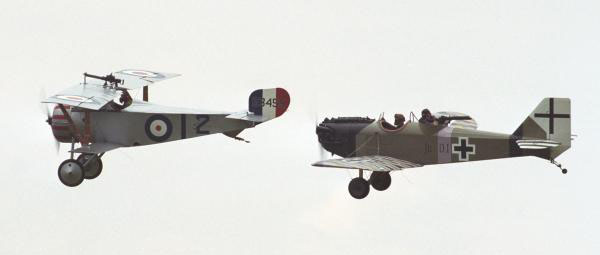
Also, Bob Gauld-Galliers sent me this very cool picture taken from the cockpit of the Nieuport. Note one other detail not really visible on the other pictures: They painted the inner part of the tires a light gray color to try to emulate the skinny tires of the typical WWI airplane.
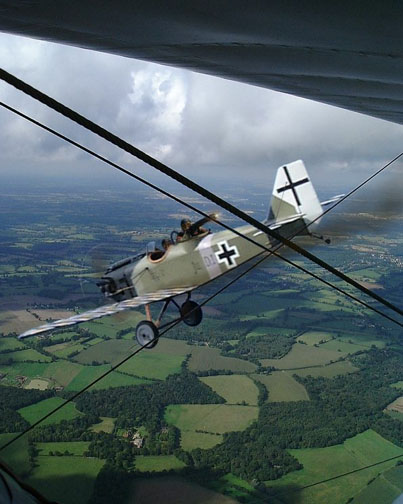
They do airshows in Great Britain as the Great War Display Team.
New! See the Second Junkers!